Analysis of Current Accounting Issues and Developments
VerifiedAdded on 2023/03/21
|23
|4717
|65
Report
AI Summary
This report examines current developments in accounting, focusing on climate-related risks and their impact on financial statements, as highlighted by the Australian Accounting Standards Board (AASB) and the Australian Securities and Investment Commission (ASIC). It discusses the importance of climate risk disclosure for investors and the role of auditors in identifying material inconsistencies. The report also analyzes the implications of the Financial Accounting Standards Board (FASB) exposure draft on financial instruments and credit losses, exploring the major issues covered and the application of the public interest theory in regulatory behavior. Furthermore, it covers investor actions, financial risks associated with climate change, and the responsibilities of directors in addressing these issues. The report also discusses the major issues covered in the exposure draft, regulator behavior according to the public interest theory, and the application of the theories of regulations. It also includes discussions from major accounting firms like KPMG LLP and Ernst & Young LLP, and concludes with an overview of the key findings and their implications.
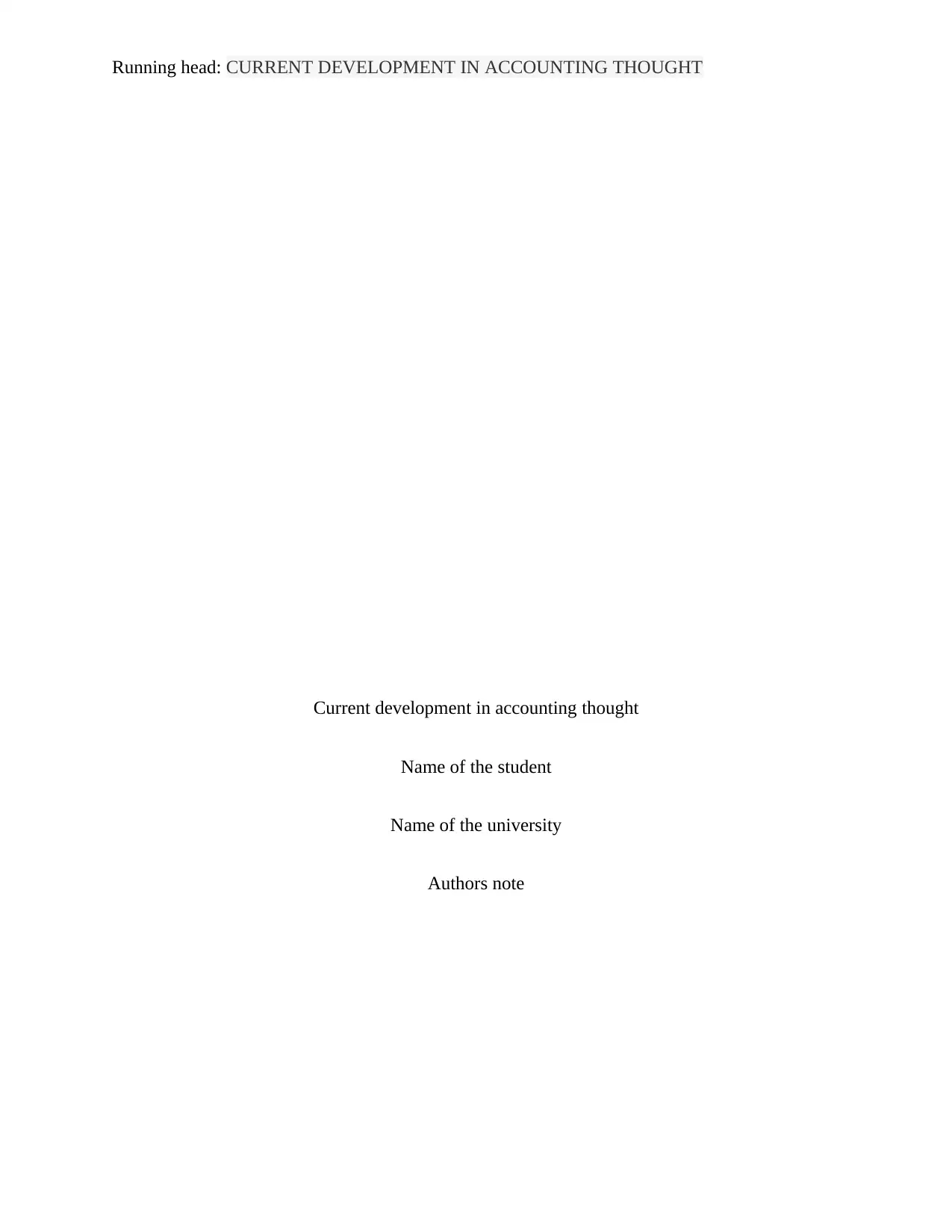
Running head: CURRENT DEVELOPMENT IN ACCOUNTING THOUGHT
Current development in accounting thought
Name of the student
Name of the university
Authors note
Current development in accounting thought
Name of the student
Name of the university
Authors note
Paraphrase This Document
Need a fresh take? Get an instant paraphrase of this document with our AI Paraphraser

1
CURRENT DEVELOPMENT IN ACCOUNTING THOUGHT
CURRENT DEVELOPMENT IN ACCOUNTING THOUGHT
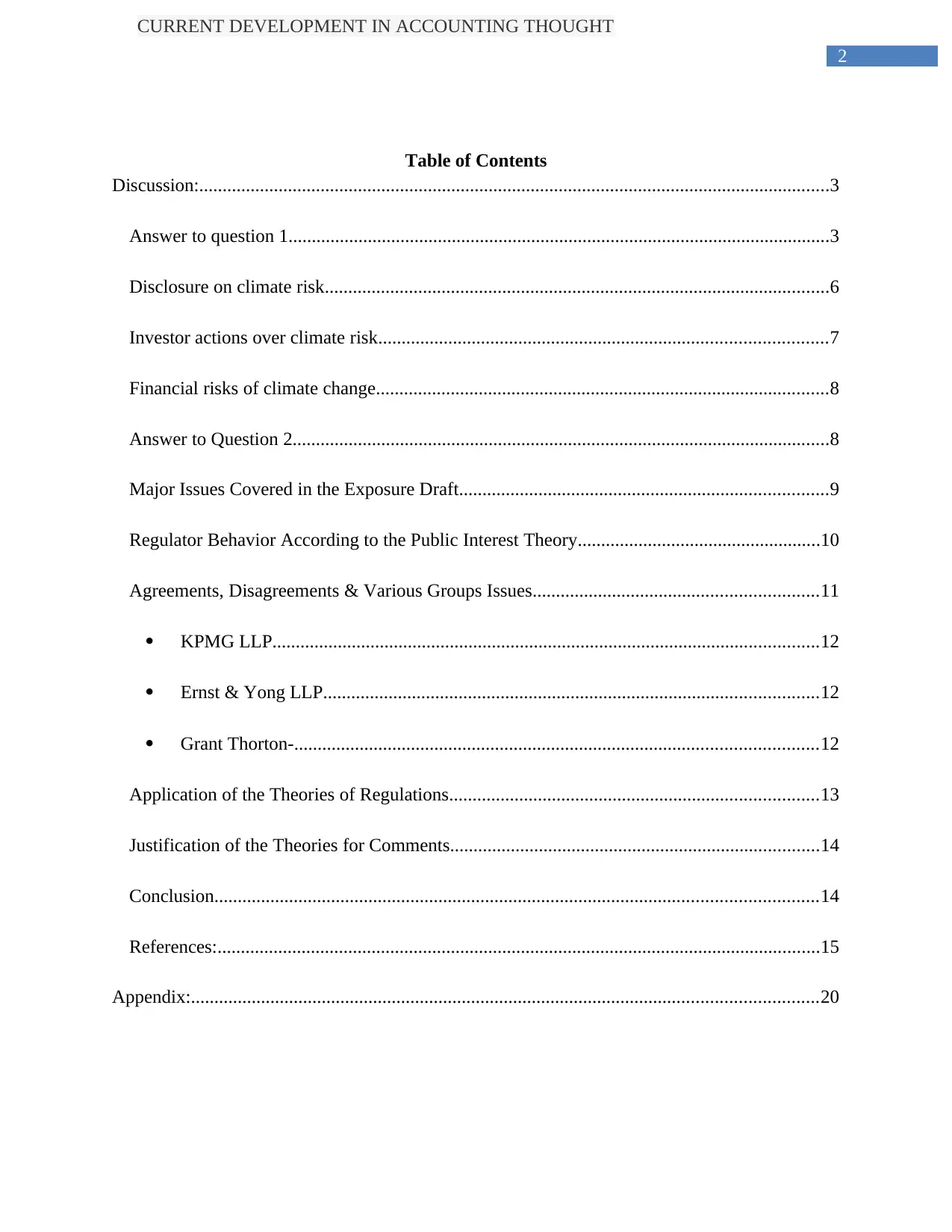
2
CURRENT DEVELOPMENT IN ACCOUNTING THOUGHT
Table of Contents
Discussion:.......................................................................................................................................3
Answer to question 1....................................................................................................................3
Disclosure on climate risk............................................................................................................6
Investor actions over climate risk................................................................................................7
Financial risks of climate change.................................................................................................8
Answer to Question 2...................................................................................................................8
Major Issues Covered in the Exposure Draft...............................................................................9
Regulator Behavior According to the Public Interest Theory....................................................10
Agreements, Disagreements & Various Groups Issues.............................................................11
KPMG LLP.....................................................................................................................12
Ernst & Yong LLP..........................................................................................................12
Grant Thorton-................................................................................................................12
Application of the Theories of Regulations...............................................................................13
Justification of the Theories for Comments...............................................................................14
Conclusion.................................................................................................................................14
References:.................................................................................................................................15
Appendix:......................................................................................................................................20
CURRENT DEVELOPMENT IN ACCOUNTING THOUGHT
Table of Contents
Discussion:.......................................................................................................................................3
Answer to question 1....................................................................................................................3
Disclosure on climate risk............................................................................................................6
Investor actions over climate risk................................................................................................7
Financial risks of climate change.................................................................................................8
Answer to Question 2...................................................................................................................8
Major Issues Covered in the Exposure Draft...............................................................................9
Regulator Behavior According to the Public Interest Theory....................................................10
Agreements, Disagreements & Various Groups Issues.............................................................11
KPMG LLP.....................................................................................................................12
Ernst & Yong LLP..........................................................................................................12
Grant Thorton-................................................................................................................12
Application of the Theories of Regulations...............................................................................13
Justification of the Theories for Comments...............................................................................14
Conclusion.................................................................................................................................14
References:.................................................................................................................................15
Appendix:......................................................................................................................................20
⊘ This is a preview!⊘
Do you want full access?
Subscribe today to unlock all pages.

Trusted by 1+ million students worldwide
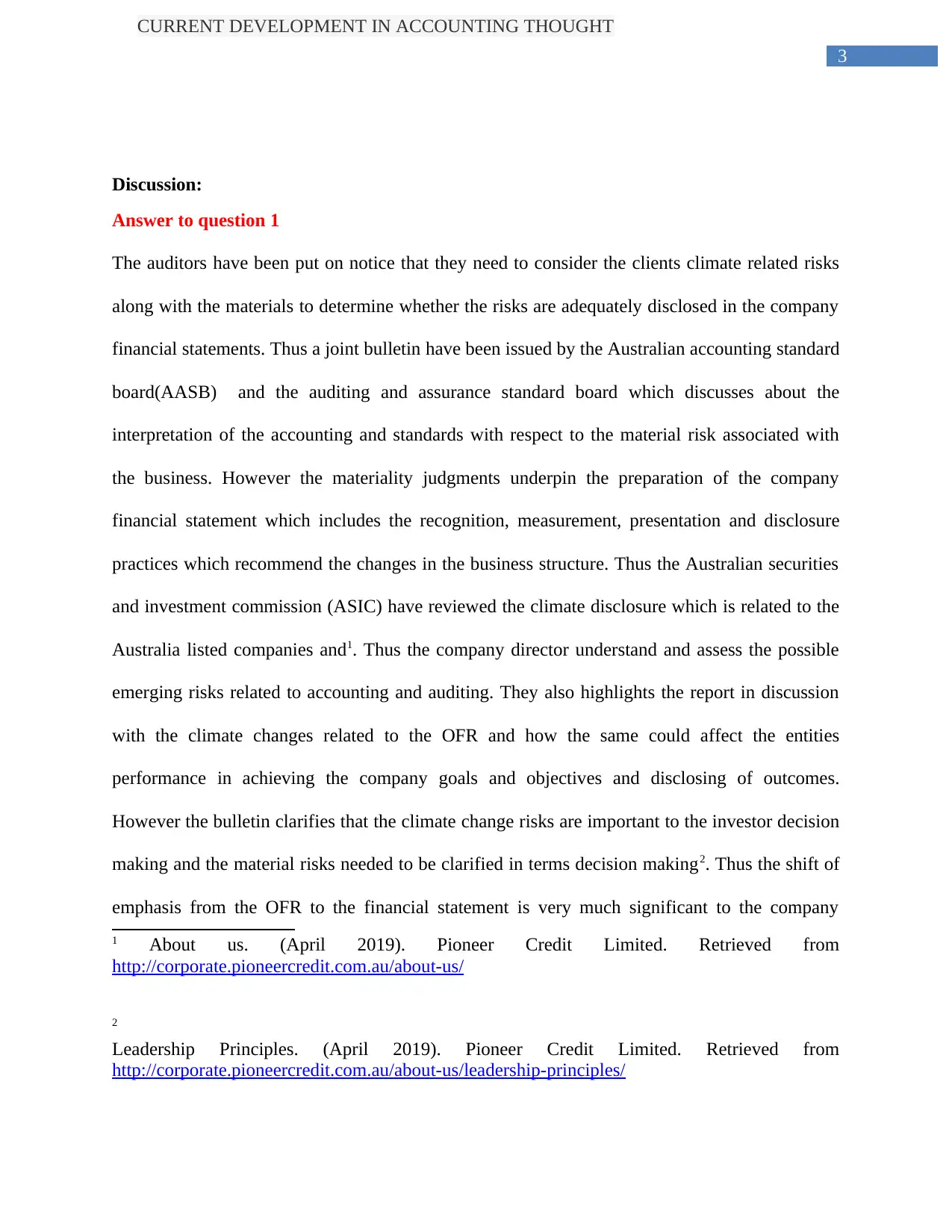
3
CURRENT DEVELOPMENT IN ACCOUNTING THOUGHT
Discussion:
Answer to question 1
The auditors have been put on notice that they need to consider the clients climate related risks
along with the materials to determine whether the risks are adequately disclosed in the company
financial statements. Thus a joint bulletin have been issued by the Australian accounting standard
board(AASB) and the auditing and assurance standard board which discusses about the
interpretation of the accounting and standards with respect to the material risk associated with
the business. However the materiality judgments underpin the preparation of the company
financial statement which includes the recognition, measurement, presentation and disclosure
practices which recommend the changes in the business structure. Thus the Australian securities
and investment commission (ASIC) have reviewed the climate disclosure which is related to the
Australia listed companies and1. Thus the company director understand and assess the possible
emerging risks related to accounting and auditing. They also highlights the report in discussion
with the climate changes related to the OFR and how the same could affect the entities
performance in achieving the company goals and objectives and disclosing of outcomes.
However the bulletin clarifies that the climate change risks are important to the investor decision
making and the material risks needed to be clarified in terms decision making2. Thus the shift of
emphasis from the OFR to the financial statement is very much significant to the company
1 About us. (April 2019). Pioneer Credit Limited. Retrieved from
http://corporate.pioneercredit.com.au/about-us/
2
Leadership Principles. (April 2019). Pioneer Credit Limited. Retrieved from
http://corporate.pioneercredit.com.au/about-us/leadership-principles/
CURRENT DEVELOPMENT IN ACCOUNTING THOUGHT
Discussion:
Answer to question 1
The auditors have been put on notice that they need to consider the clients climate related risks
along with the materials to determine whether the risks are adequately disclosed in the company
financial statements. Thus a joint bulletin have been issued by the Australian accounting standard
board(AASB) and the auditing and assurance standard board which discusses about the
interpretation of the accounting and standards with respect to the material risk associated with
the business. However the materiality judgments underpin the preparation of the company
financial statement which includes the recognition, measurement, presentation and disclosure
practices which recommend the changes in the business structure. Thus the Australian securities
and investment commission (ASIC) have reviewed the climate disclosure which is related to the
Australia listed companies and1. Thus the company director understand and assess the possible
emerging risks related to accounting and auditing. They also highlights the report in discussion
with the climate changes related to the OFR and how the same could affect the entities
performance in achieving the company goals and objectives and disclosing of outcomes.
However the bulletin clarifies that the climate change risks are important to the investor decision
making and the material risks needed to be clarified in terms decision making2. Thus the shift of
emphasis from the OFR to the financial statement is very much significant to the company
1 About us. (April 2019). Pioneer Credit Limited. Retrieved from
http://corporate.pioneercredit.com.au/about-us/
2
Leadership Principles. (April 2019). Pioneer Credit Limited. Retrieved from
http://corporate.pioneercredit.com.au/about-us/leadership-principles/
Paraphrase This Document
Need a fresh take? Get an instant paraphrase of this document with our AI Paraphraser
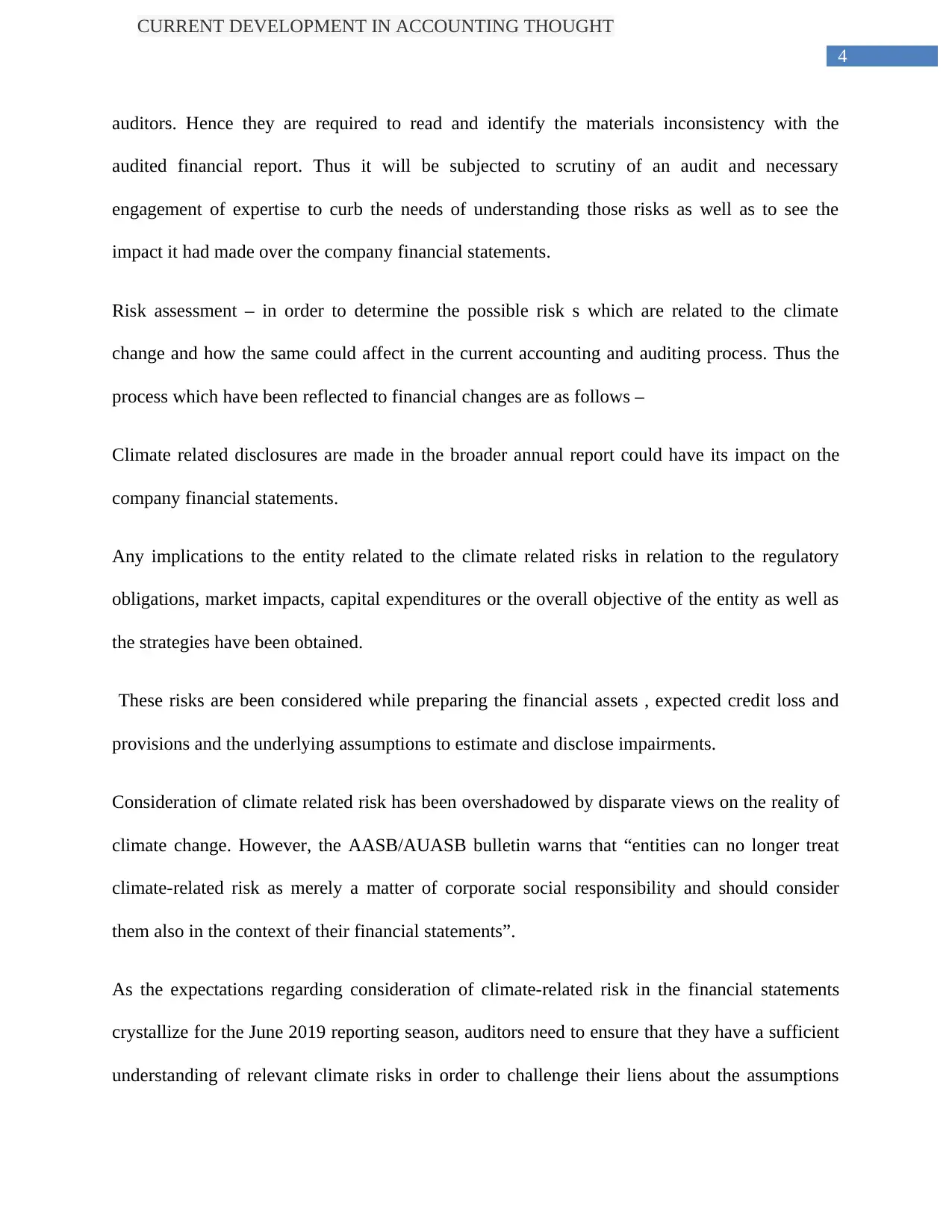
4
CURRENT DEVELOPMENT IN ACCOUNTING THOUGHT
auditors. Hence they are required to read and identify the materials inconsistency with the
audited financial report. Thus it will be subjected to scrutiny of an audit and necessary
engagement of expertise to curb the needs of understanding those risks as well as to see the
impact it had made over the company financial statements.
Risk assessment – in order to determine the possible risk s which are related to the climate
change and how the same could affect in the current accounting and auditing process. Thus the
process which have been reflected to financial changes are as follows –
Climate related disclosures are made in the broader annual report could have its impact on the
company financial statements.
Any implications to the entity related to the climate related risks in relation to the regulatory
obligations, market impacts, capital expenditures or the overall objective of the entity as well as
the strategies have been obtained.
These risks are been considered while preparing the financial assets , expected credit loss and
provisions and the underlying assumptions to estimate and disclose impairments.
Consideration of climate related risk has been overshadowed by disparate views on the reality of
climate change. However, the AASB/AUASB bulletin warns that “entities can no longer treat
climate-related risk as merely a matter of corporate social responsibility and should consider
them also in the context of their financial statements”.
As the expectations regarding consideration of climate-related risk in the financial statements
crystallize for the June 2019 reporting season, auditors need to ensure that they have a sufficient
understanding of relevant climate risks in order to challenge their liens about the assumptions
CURRENT DEVELOPMENT IN ACCOUNTING THOUGHT
auditors. Hence they are required to read and identify the materials inconsistency with the
audited financial report. Thus it will be subjected to scrutiny of an audit and necessary
engagement of expertise to curb the needs of understanding those risks as well as to see the
impact it had made over the company financial statements.
Risk assessment – in order to determine the possible risk s which are related to the climate
change and how the same could affect in the current accounting and auditing process. Thus the
process which have been reflected to financial changes are as follows –
Climate related disclosures are made in the broader annual report could have its impact on the
company financial statements.
Any implications to the entity related to the climate related risks in relation to the regulatory
obligations, market impacts, capital expenditures or the overall objective of the entity as well as
the strategies have been obtained.
These risks are been considered while preparing the financial assets , expected credit loss and
provisions and the underlying assumptions to estimate and disclose impairments.
Consideration of climate related risk has been overshadowed by disparate views on the reality of
climate change. However, the AASB/AUASB bulletin warns that “entities can no longer treat
climate-related risk as merely a matter of corporate social responsibility and should consider
them also in the context of their financial statements”.
As the expectations regarding consideration of climate-related risk in the financial statements
crystallize for the June 2019 reporting season, auditors need to ensure that they have a sufficient
understanding of relevant climate risks in order to challenge their liens about the assumptions
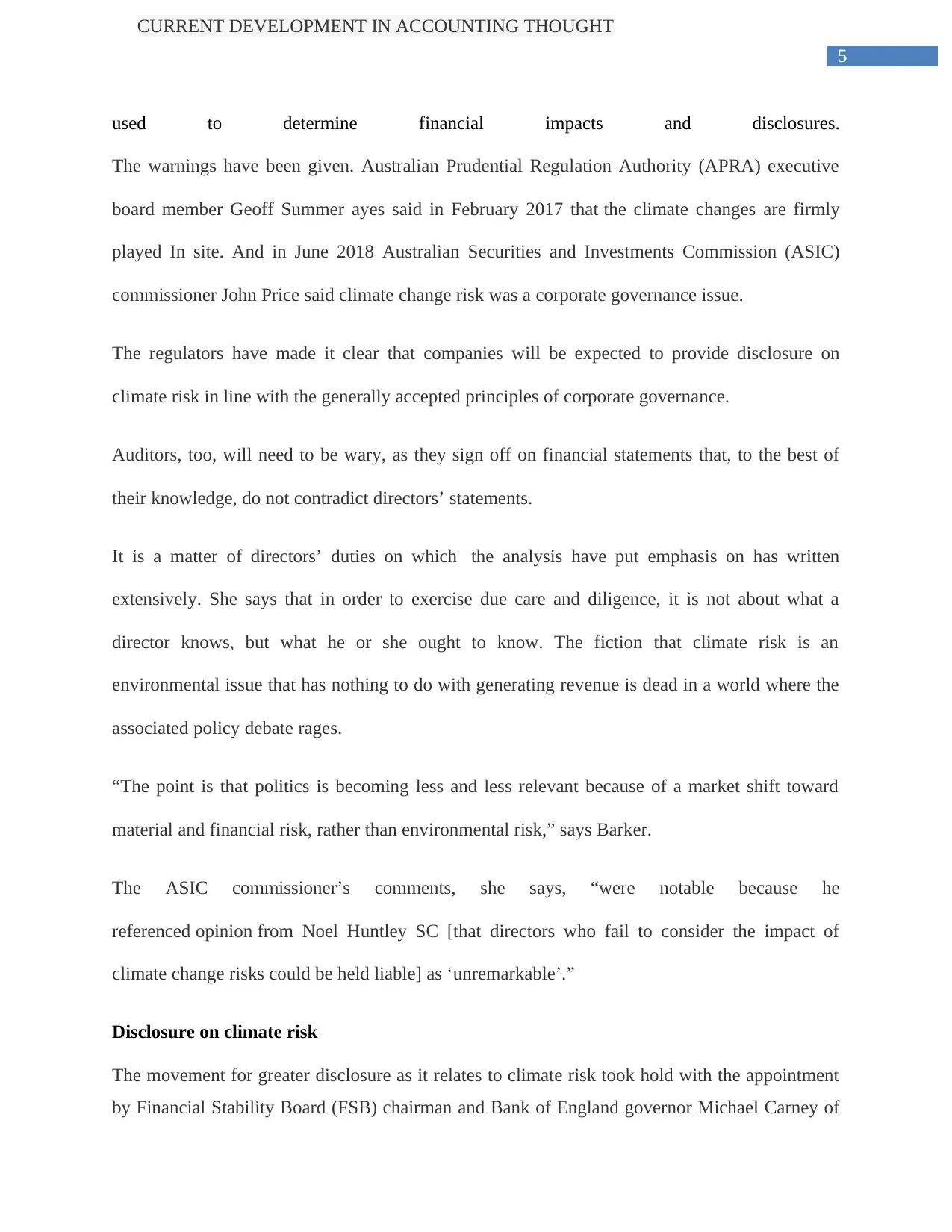
5
CURRENT DEVELOPMENT IN ACCOUNTING THOUGHT
used to determine financial impacts and disclosures.
The warnings have been given. Australian Prudential Regulation Authority (APRA) executive
board member Geoff Summer ayes said in February 2017 that the climate changes are firmly
played In site. And in June 2018 Australian Securities and Investments Commission (ASIC)
commissioner John Price said climate change risk was a corporate governance issue.
The regulators have made it clear that companies will be expected to provide disclosure on
climate risk in line with the generally accepted principles of corporate governance.
Auditors, too, will need to be wary, as they sign off on financial statements that, to the best of
their knowledge, do not contradict directors’ statements.
It is a matter of directors’ duties on which the analysis have put emphasis on has written
extensively. She says that in order to exercise due care and diligence, it is not about what a
director knows, but what he or she ought to know. The fiction that climate risk is an
environmental issue that has nothing to do with generating revenue is dead in a world where the
associated policy debate rages.
“The point is that politics is becoming less and less relevant because of a market shift toward
material and financial risk, rather than environmental risk,” says Barker.
The ASIC commissioner’s comments, she says, “were notable because he
referenced opinion from Noel Huntley SC [that directors who fail to consider the impact of
climate change risks could be held liable] as ‘unremarkable’.”
Disclosure on climate risk
The movement for greater disclosure as it relates to climate risk took hold with the appointment
by Financial Stability Board (FSB) chairman and Bank of England governor Michael Carney of
CURRENT DEVELOPMENT IN ACCOUNTING THOUGHT
used to determine financial impacts and disclosures.
The warnings have been given. Australian Prudential Regulation Authority (APRA) executive
board member Geoff Summer ayes said in February 2017 that the climate changes are firmly
played In site. And in June 2018 Australian Securities and Investments Commission (ASIC)
commissioner John Price said climate change risk was a corporate governance issue.
The regulators have made it clear that companies will be expected to provide disclosure on
climate risk in line with the generally accepted principles of corporate governance.
Auditors, too, will need to be wary, as they sign off on financial statements that, to the best of
their knowledge, do not contradict directors’ statements.
It is a matter of directors’ duties on which the analysis have put emphasis on has written
extensively. She says that in order to exercise due care and diligence, it is not about what a
director knows, but what he or she ought to know. The fiction that climate risk is an
environmental issue that has nothing to do with generating revenue is dead in a world where the
associated policy debate rages.
“The point is that politics is becoming less and less relevant because of a market shift toward
material and financial risk, rather than environmental risk,” says Barker.
The ASIC commissioner’s comments, she says, “were notable because he
referenced opinion from Noel Huntley SC [that directors who fail to consider the impact of
climate change risks could be held liable] as ‘unremarkable’.”
Disclosure on climate risk
The movement for greater disclosure as it relates to climate risk took hold with the appointment
by Financial Stability Board (FSB) chairman and Bank of England governor Michael Carney of
⊘ This is a preview!⊘
Do you want full access?
Subscribe today to unlock all pages.

Trusted by 1+ million students worldwide
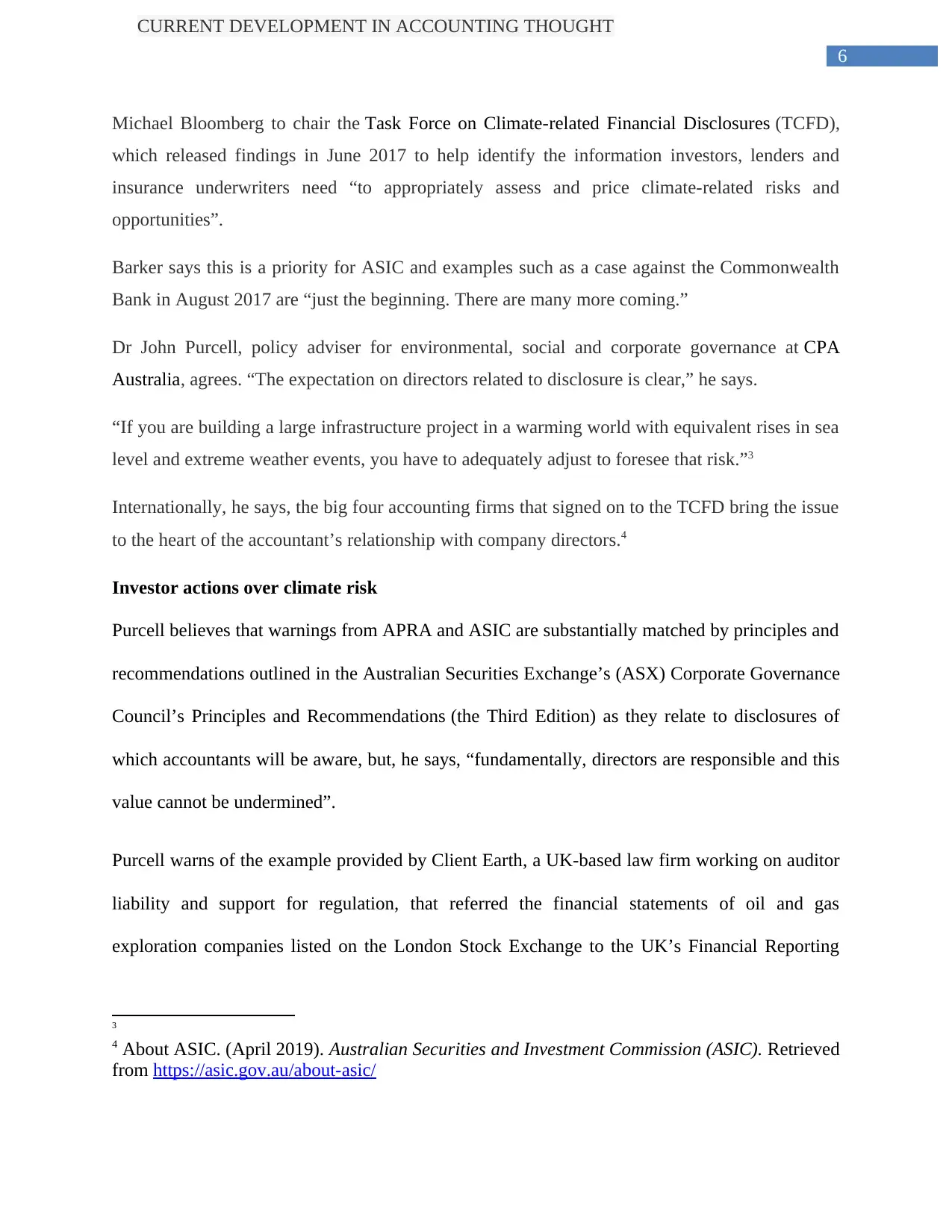
6
CURRENT DEVELOPMENT IN ACCOUNTING THOUGHT
Michael Bloomberg to chair the Task Force on Climate-related Financial Disclosures (TCFD),
which released findings in June 2017 to help identify the information investors, lenders and
insurance underwriters need “to appropriately assess and price climate-related risks and
opportunities”.
Barker says this is a priority for ASIC and examples such as a case against the Commonwealth
Bank in August 2017 are “just the beginning. There are many more coming.”
Dr John Purcell, policy adviser for environmental, social and corporate governance at CPA
Australia, agrees. “The expectation on directors related to disclosure is clear,” he says.
“If you are building a large infrastructure project in a warming world with equivalent rises in sea
level and extreme weather events, you have to adequately adjust to foresee that risk.”3
Internationally, he says, the big four accounting firms that signed on to the TCFD bring the issue
to the heart of the accountant’s relationship with company directors.4
Investor actions over climate risk
Purcell believes that warnings from APRA and ASIC are substantially matched by principles and
recommendations outlined in the Australian Securities Exchange’s (ASX) Corporate Governance
Council’s Principles and Recommendations (the Third Edition) as they relate to disclosures of
which accountants will be aware, but, he says, “fundamentally, directors are responsible and this
value cannot be undermined”.
Purcell warns of the example provided by Client Earth, a UK-based law firm working on auditor
liability and support for regulation, that referred the financial statements of oil and gas
exploration companies listed on the London Stock Exchange to the UK’s Financial Reporting
3
4 About ASIC. (April 2019). Australian Securities and Investment Commission (ASIC). Retrieved
from https://asic.gov.au/about-asic/
CURRENT DEVELOPMENT IN ACCOUNTING THOUGHT
Michael Bloomberg to chair the Task Force on Climate-related Financial Disclosures (TCFD),
which released findings in June 2017 to help identify the information investors, lenders and
insurance underwriters need “to appropriately assess and price climate-related risks and
opportunities”.
Barker says this is a priority for ASIC and examples such as a case against the Commonwealth
Bank in August 2017 are “just the beginning. There are many more coming.”
Dr John Purcell, policy adviser for environmental, social and corporate governance at CPA
Australia, agrees. “The expectation on directors related to disclosure is clear,” he says.
“If you are building a large infrastructure project in a warming world with equivalent rises in sea
level and extreme weather events, you have to adequately adjust to foresee that risk.”3
Internationally, he says, the big four accounting firms that signed on to the TCFD bring the issue
to the heart of the accountant’s relationship with company directors.4
Investor actions over climate risk
Purcell believes that warnings from APRA and ASIC are substantially matched by principles and
recommendations outlined in the Australian Securities Exchange’s (ASX) Corporate Governance
Council’s Principles and Recommendations (the Third Edition) as they relate to disclosures of
which accountants will be aware, but, he says, “fundamentally, directors are responsible and this
value cannot be undermined”.
Purcell warns of the example provided by Client Earth, a UK-based law firm working on auditor
liability and support for regulation, that referred the financial statements of oil and gas
exploration companies listed on the London Stock Exchange to the UK’s Financial Reporting
3
4 About ASIC. (April 2019). Australian Securities and Investment Commission (ASIC). Retrieved
from https://asic.gov.au/about-asic/
Paraphrase This Document
Need a fresh take? Get an instant paraphrase of this document with our AI Paraphraser
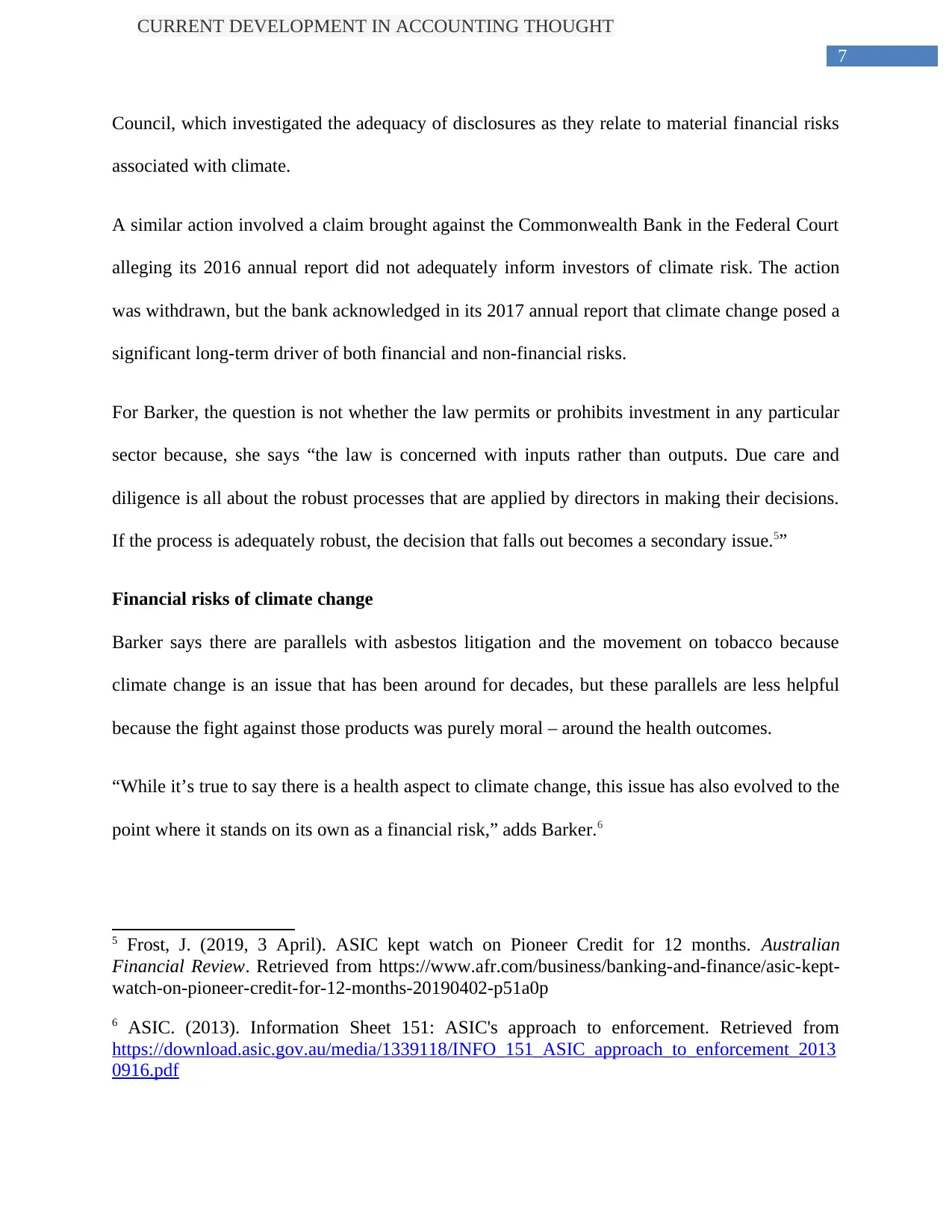
7
CURRENT DEVELOPMENT IN ACCOUNTING THOUGHT
Council, which investigated the adequacy of disclosures as they relate to material financial risks
associated with climate.
A similar action involved a claim brought against the Commonwealth Bank in the Federal Court
alleging its 2016 annual report did not adequately inform investors of climate risk. The action
was withdrawn, but the bank acknowledged in its 2017 annual report that climate change posed a
significant long-term driver of both financial and non-financial risks.
For Barker, the question is not whether the law permits or prohibits investment in any particular
sector because, she says “the law is concerned with inputs rather than outputs. Due care and
diligence is all about the robust processes that are applied by directors in making their decisions.
If the process is adequately robust, the decision that falls out becomes a secondary issue.5”
Financial risks of climate change
Barker says there are parallels with asbestos litigation and the movement on tobacco because
climate change is an issue that has been around for decades, but these parallels are less helpful
because the fight against those products was purely moral – around the health outcomes.
“While it’s true to say there is a health aspect to climate change, this issue has also evolved to the
point where it stands on its own as a financial risk,” adds Barker.6
5 Frost, J. (2019, 3 April). ASIC kept watch on Pioneer Credit for 12 months. Australian
Financial Review. Retrieved from https://www.afr.com/business/banking-and-finance/asic-kept-
watch-on-pioneer-credit-for-12-months-20190402-p51a0p
6 ASIC. (2013). Information Sheet 151: ASIC's approach to enforcement. Retrieved from
https://download.asic.gov.au/media/1339118/INFO_151_ASIC_approach_to_enforcement_2013
0916.pdf
CURRENT DEVELOPMENT IN ACCOUNTING THOUGHT
Council, which investigated the adequacy of disclosures as they relate to material financial risks
associated with climate.
A similar action involved a claim brought against the Commonwealth Bank in the Federal Court
alleging its 2016 annual report did not adequately inform investors of climate risk. The action
was withdrawn, but the bank acknowledged in its 2017 annual report that climate change posed a
significant long-term driver of both financial and non-financial risks.
For Barker, the question is not whether the law permits or prohibits investment in any particular
sector because, she says “the law is concerned with inputs rather than outputs. Due care and
diligence is all about the robust processes that are applied by directors in making their decisions.
If the process is adequately robust, the decision that falls out becomes a secondary issue.5”
Financial risks of climate change
Barker says there are parallels with asbestos litigation and the movement on tobacco because
climate change is an issue that has been around for decades, but these parallels are less helpful
because the fight against those products was purely moral – around the health outcomes.
“While it’s true to say there is a health aspect to climate change, this issue has also evolved to the
point where it stands on its own as a financial risk,” adds Barker.6
5 Frost, J. (2019, 3 April). ASIC kept watch on Pioneer Credit for 12 months. Australian
Financial Review. Retrieved from https://www.afr.com/business/banking-and-finance/asic-kept-
watch-on-pioneer-credit-for-12-months-20190402-p51a0p
6 ASIC. (2013). Information Sheet 151: ASIC's approach to enforcement. Retrieved from
https://download.asic.gov.au/media/1339118/INFO_151_ASIC_approach_to_enforcement_2013
0916.pdf
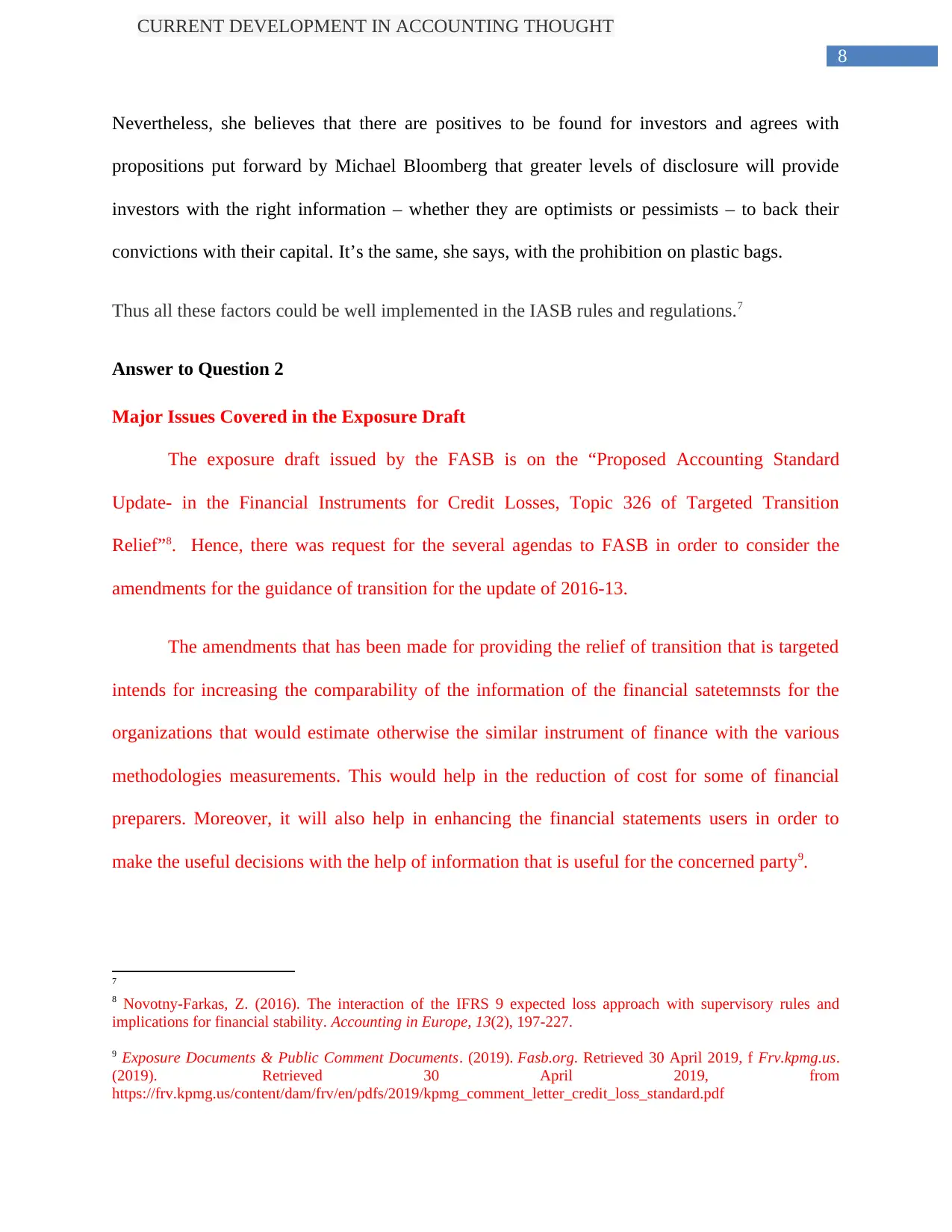
8
CURRENT DEVELOPMENT IN ACCOUNTING THOUGHT
Nevertheless, she believes that there are positives to be found for investors and agrees with
propositions put forward by Michael Bloomberg that greater levels of disclosure will provide
investors with the right information – whether they are optimists or pessimists – to back their
convictions with their capital. It’s the same, she says, with the prohibition on plastic bags.
Thus all these factors could be well implemented in the IASB rules and regulations.7
Answer to Question 2
Major Issues Covered in the Exposure Draft
The exposure draft issued by the FASB is on the “Proposed Accounting Standard
Update- in the Financial Instruments for Credit Losses, Topic 326 of Targeted Transition
Relief”8. Hence, there was request for the several agendas to FASB in order to consider the
amendments for the guidance of transition for the update of 2016-13.
The amendments that has been made for providing the relief of transition that is targeted
intends for increasing the comparability of the information of the financial satetemnsts for the
organizations that would estimate otherwise the similar instrument of finance with the various
methodologies measurements. This would help in the reduction of cost for some of financial
preparers. Moreover, it will also help in enhancing the financial statements users in order to
make the useful decisions with the help of information that is useful for the concerned party9.
7
8 Novotny-Farkas, Z. (2016). The interaction of the IFRS 9 expected loss approach with supervisory rules and
implications for financial stability. Accounting in Europe, 13(2), 197-227.
9 Exposure Documents & Public Comment Documents. (2019). Fasb.org. Retrieved 30 April 2019, f Frv.kpmg.us.
(2019). Retrieved 30 April 2019, from
https://frv.kpmg.us/content/dam/frv/en/pdfs/2019/kpmg_comment_letter_credit_loss_standard.pdf
CURRENT DEVELOPMENT IN ACCOUNTING THOUGHT
Nevertheless, she believes that there are positives to be found for investors and agrees with
propositions put forward by Michael Bloomberg that greater levels of disclosure will provide
investors with the right information – whether they are optimists or pessimists – to back their
convictions with their capital. It’s the same, she says, with the prohibition on plastic bags.
Thus all these factors could be well implemented in the IASB rules and regulations.7
Answer to Question 2
Major Issues Covered in the Exposure Draft
The exposure draft issued by the FASB is on the “Proposed Accounting Standard
Update- in the Financial Instruments for Credit Losses, Topic 326 of Targeted Transition
Relief”8. Hence, there was request for the several agendas to FASB in order to consider the
amendments for the guidance of transition for the update of 2016-13.
The amendments that has been made for providing the relief of transition that is targeted
intends for increasing the comparability of the information of the financial satetemnsts for the
organizations that would estimate otherwise the similar instrument of finance with the various
methodologies measurements. This would help in the reduction of cost for some of financial
preparers. Moreover, it will also help in enhancing the financial statements users in order to
make the useful decisions with the help of information that is useful for the concerned party9.
7
8 Novotny-Farkas, Z. (2016). The interaction of the IFRS 9 expected loss approach with supervisory rules and
implications for financial stability. Accounting in Europe, 13(2), 197-227.
9 Exposure Documents & Public Comment Documents. (2019). Fasb.org. Retrieved 30 April 2019, f Frv.kpmg.us.
(2019). Retrieved 30 April 2019, from
https://frv.kpmg.us/content/dam/frv/en/pdfs/2019/kpmg_comment_letter_credit_loss_standard.pdf
⊘ This is a preview!⊘
Do you want full access?
Subscribe today to unlock all pages.

Trusted by 1+ million students worldwide
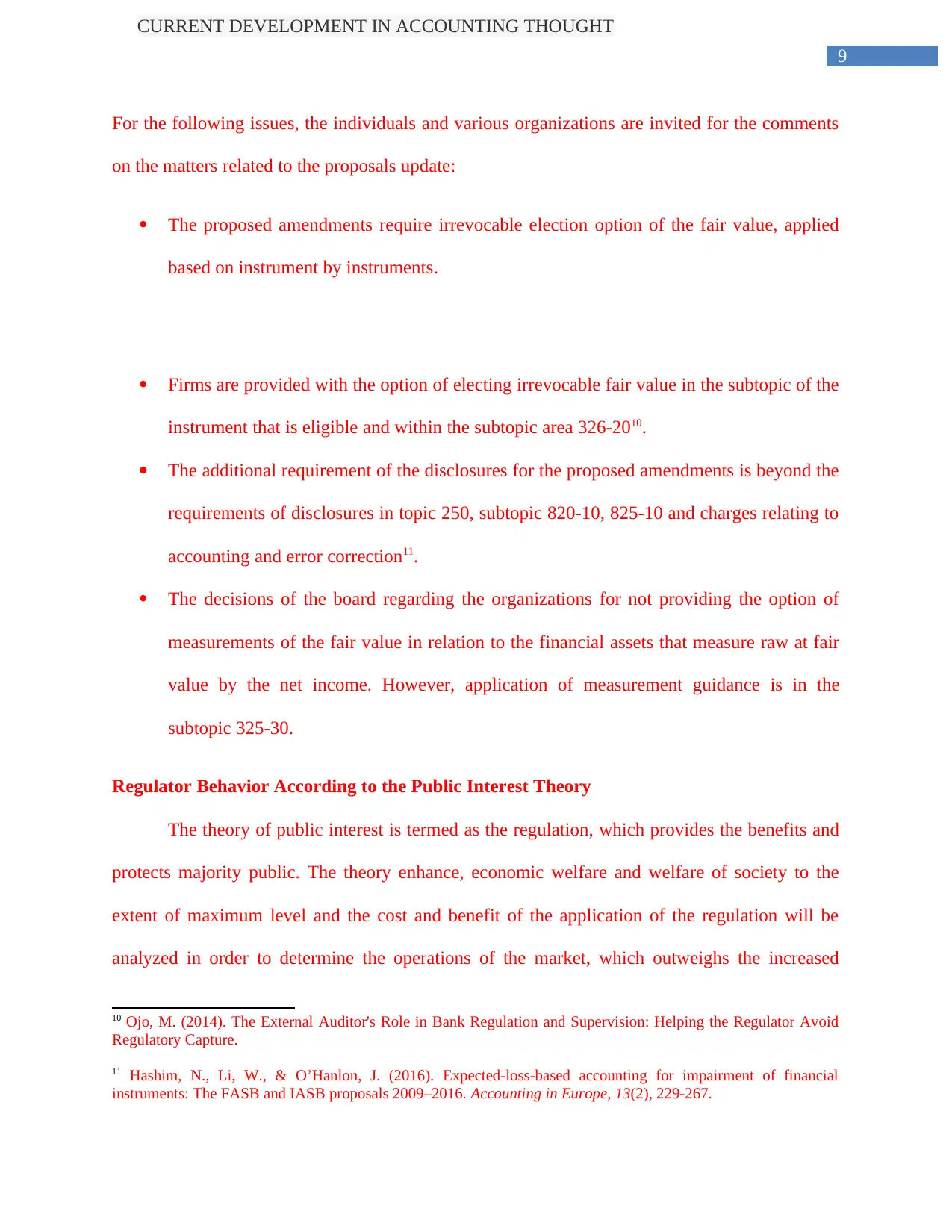
9
CURRENT DEVELOPMENT IN ACCOUNTING THOUGHT
For the following issues, the individuals and various organizations are invited for the comments
on the matters related to the proposals update:
The proposed amendments require irrevocable election option of the fair value, applied
based on instrument by instruments.
Firms are provided with the option of electing irrevocable fair value in the subtopic of the
instrument that is eligible and within the subtopic area 326-2010.
The additional requirement of the disclosures for the proposed amendments is beyond the
requirements of disclosures in topic 250, subtopic 820-10, 825-10 and charges relating to
accounting and error correction11.
The decisions of the board regarding the organizations for not providing the option of
measurements of the fair value in relation to the financial assets that measure raw at fair
value by the net income. However, application of measurement guidance is in the
subtopic 325-30.
Regulator Behavior According to the Public Interest Theory
The theory of public interest is termed as the regulation, which provides the benefits and
protects majority public. The theory enhance, economic welfare and welfare of society to the
extent of maximum level and the cost and benefit of the application of the regulation will be
analyzed in order to determine the operations of the market, which outweighs the increased
10 Ojo, M. (2014). The External Auditor's Role in Bank Regulation and Supervision: Helping the Regulator Avoid
Regulatory Capture.
11 Hashim, N., Li, W., & O’Hanlon, J. (2016). Expected-loss-based accounting for impairment of financial
instruments: The FASB and IASB proposals 2009–2016. Accounting in Europe, 13(2), 229-267.
CURRENT DEVELOPMENT IN ACCOUNTING THOUGHT
For the following issues, the individuals and various organizations are invited for the comments
on the matters related to the proposals update:
The proposed amendments require irrevocable election option of the fair value, applied
based on instrument by instruments.
Firms are provided with the option of electing irrevocable fair value in the subtopic of the
instrument that is eligible and within the subtopic area 326-2010.
The additional requirement of the disclosures for the proposed amendments is beyond the
requirements of disclosures in topic 250, subtopic 820-10, 825-10 and charges relating to
accounting and error correction11.
The decisions of the board regarding the organizations for not providing the option of
measurements of the fair value in relation to the financial assets that measure raw at fair
value by the net income. However, application of measurement guidance is in the
subtopic 325-30.
Regulator Behavior According to the Public Interest Theory
The theory of public interest is termed as the regulation, which provides the benefits and
protects majority public. The theory enhance, economic welfare and welfare of society to the
extent of maximum level and the cost and benefit of the application of the regulation will be
analyzed in order to determine the operations of the market, which outweighs the increased
10 Ojo, M. (2014). The External Auditor's Role in Bank Regulation and Supervision: Helping the Regulator Avoid
Regulatory Capture.
11 Hashim, N., Li, W., & O’Hanlon, J. (2016). Expected-loss-based accounting for impairment of financial
instruments: The FASB and IASB proposals 2009–2016. Accounting in Europe, 13(2), 229-267.
Paraphrase This Document
Need a fresh take? Get an instant paraphrase of this document with our AI Paraphraser
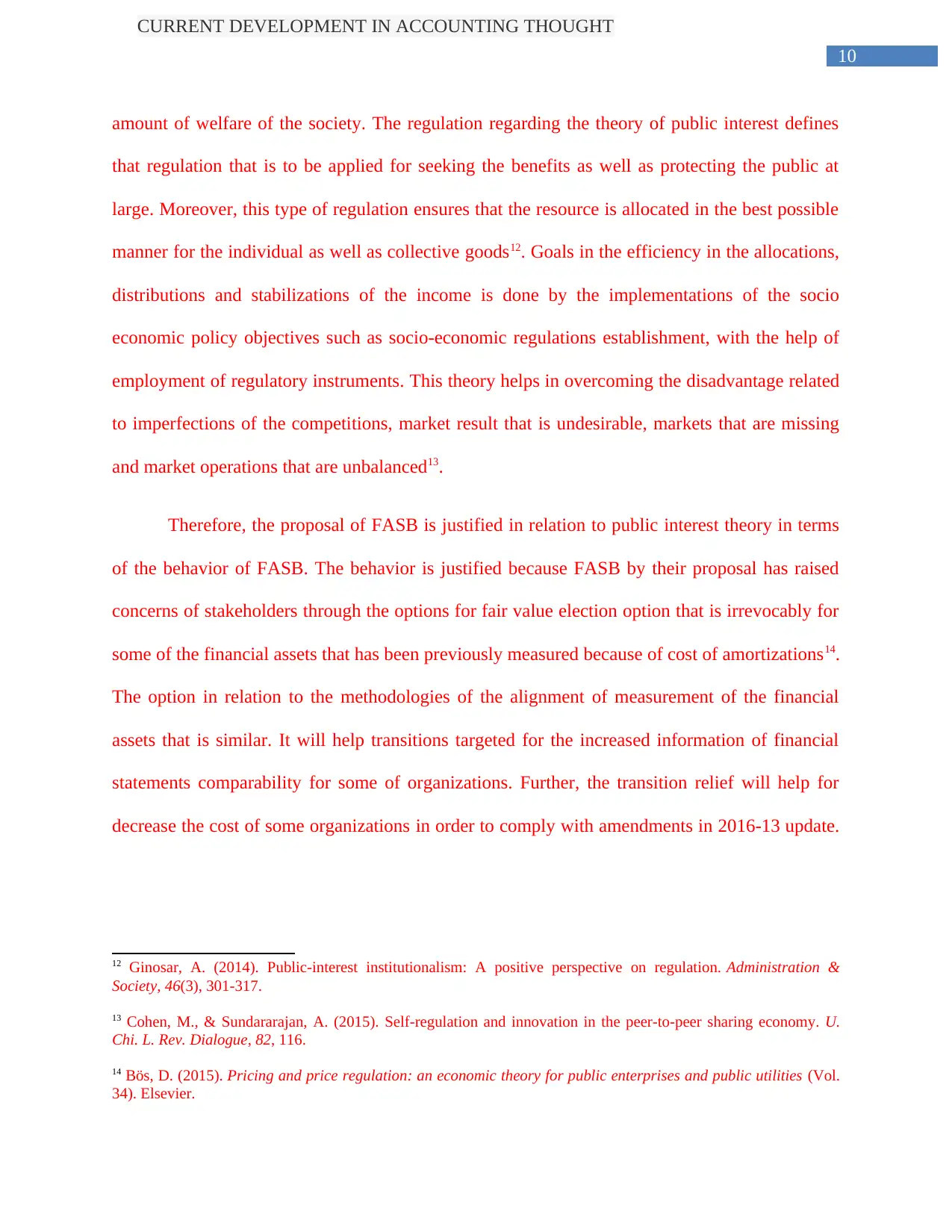
10
CURRENT DEVELOPMENT IN ACCOUNTING THOUGHT
amount of welfare of the society. The regulation regarding the theory of public interest defines
that regulation that is to be applied for seeking the benefits as well as protecting the public at
large. Moreover, this type of regulation ensures that the resource is allocated in the best possible
manner for the individual as well as collective goods12. Goals in the efficiency in the allocations,
distributions and stabilizations of the income is done by the implementations of the socio
economic policy objectives such as socio-economic regulations establishment, with the help of
employment of regulatory instruments. This theory helps in overcoming the disadvantage related
to imperfections of the competitions, market result that is undesirable, markets that are missing
and market operations that are unbalanced13.
Therefore, the proposal of FASB is justified in relation to public interest theory in terms
of the behavior of FASB. The behavior is justified because FASB by their proposal has raised
concerns of stakeholders through the options for fair value election option that is irrevocably for
some of the financial assets that has been previously measured because of cost of amortizations14.
The option in relation to the methodologies of the alignment of measurement of the financial
assets that is similar. It will help transitions targeted for the increased information of financial
statements comparability for some of organizations. Further, the transition relief will help for
decrease the cost of some organizations in order to comply with amendments in 2016-13 update.
12 Ginosar, A. (2014). Public-interest institutionalism: A positive perspective on regulation. Administration &
Society, 46(3), 301-317.
13 Cohen, M., & Sundararajan, A. (2015). Self-regulation and innovation in the peer-to-peer sharing economy. U.
Chi. L. Rev. Dialogue, 82, 116.
14 Bös, D. (2015). Pricing and price regulation: an economic theory for public enterprises and public utilities (Vol.
34). Elsevier.
CURRENT DEVELOPMENT IN ACCOUNTING THOUGHT
amount of welfare of the society. The regulation regarding the theory of public interest defines
that regulation that is to be applied for seeking the benefits as well as protecting the public at
large. Moreover, this type of regulation ensures that the resource is allocated in the best possible
manner for the individual as well as collective goods12. Goals in the efficiency in the allocations,
distributions and stabilizations of the income is done by the implementations of the socio
economic policy objectives such as socio-economic regulations establishment, with the help of
employment of regulatory instruments. This theory helps in overcoming the disadvantage related
to imperfections of the competitions, market result that is undesirable, markets that are missing
and market operations that are unbalanced13.
Therefore, the proposal of FASB is justified in relation to public interest theory in terms
of the behavior of FASB. The behavior is justified because FASB by their proposal has raised
concerns of stakeholders through the options for fair value election option that is irrevocably for
some of the financial assets that has been previously measured because of cost of amortizations14.
The option in relation to the methodologies of the alignment of measurement of the financial
assets that is similar. It will help transitions targeted for the increased information of financial
statements comparability for some of organizations. Further, the transition relief will help for
decrease the cost of some organizations in order to comply with amendments in 2016-13 update.
12 Ginosar, A. (2014). Public-interest institutionalism: A positive perspective on regulation. Administration &
Society, 46(3), 301-317.
13 Cohen, M., & Sundararajan, A. (2015). Self-regulation and innovation in the peer-to-peer sharing economy. U.
Chi. L. Rev. Dialogue, 82, 116.
14 Bös, D. (2015). Pricing and price regulation: an economic theory for public enterprises and public utilities (Vol.
34). Elsevier.
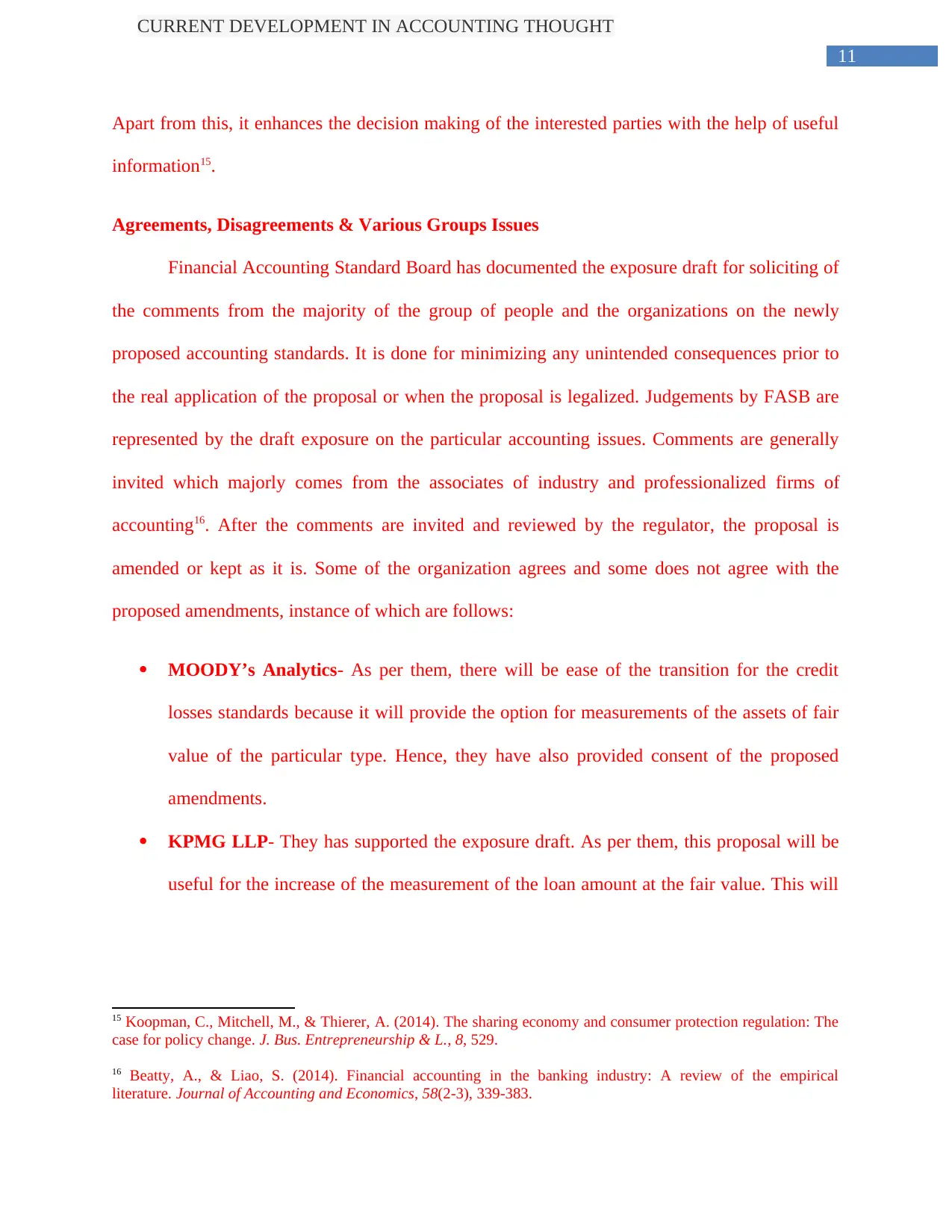
11
CURRENT DEVELOPMENT IN ACCOUNTING THOUGHT
Apart from this, it enhances the decision making of the interested parties with the help of useful
information15.
Agreements, Disagreements & Various Groups Issues
Financial Accounting Standard Board has documented the exposure draft for soliciting of
the comments from the majority of the group of people and the organizations on the newly
proposed accounting standards. It is done for minimizing any unintended consequences prior to
the real application of the proposal or when the proposal is legalized. Judgements by FASB are
represented by the draft exposure on the particular accounting issues. Comments are generally
invited which majorly comes from the associates of industry and professionalized firms of
accounting16. After the comments are invited and reviewed by the regulator, the proposal is
amended or kept as it is. Some of the organization agrees and some does not agree with the
proposed amendments, instance of which are follows:
MOODY’s Analytics- As per them, there will be ease of the transition for the credit
losses standards because it will provide the option for measurements of the assets of fair
value of the particular type. Hence, they have also provided consent of the proposed
amendments.
KPMG LLP- They has supported the exposure draft. As per them, this proposal will be
useful for the increase of the measurement of the loan amount at the fair value. This will
15 Koopman, C., Mitchell, M., & Thierer, A. (2014). The sharing economy and consumer protection regulation: The
case for policy change. J. Bus. Entrepreneurship & L., 8, 529.
16 Beatty, A., & Liao, S. (2014). Financial accounting in the banking industry: A review of the empirical
literature. Journal of Accounting and Economics, 58(2-3), 339-383.
CURRENT DEVELOPMENT IN ACCOUNTING THOUGHT
Apart from this, it enhances the decision making of the interested parties with the help of useful
information15.
Agreements, Disagreements & Various Groups Issues
Financial Accounting Standard Board has documented the exposure draft for soliciting of
the comments from the majority of the group of people and the organizations on the newly
proposed accounting standards. It is done for minimizing any unintended consequences prior to
the real application of the proposal or when the proposal is legalized. Judgements by FASB are
represented by the draft exposure on the particular accounting issues. Comments are generally
invited which majorly comes from the associates of industry and professionalized firms of
accounting16. After the comments are invited and reviewed by the regulator, the proposal is
amended or kept as it is. Some of the organization agrees and some does not agree with the
proposed amendments, instance of which are follows:
MOODY’s Analytics- As per them, there will be ease of the transition for the credit
losses standards because it will provide the option for measurements of the assets of fair
value of the particular type. Hence, they have also provided consent of the proposed
amendments.
KPMG LLP- They has supported the exposure draft. As per them, this proposal will be
useful for the increase of the measurement of the loan amount at the fair value. This will
15 Koopman, C., Mitchell, M., & Thierer, A. (2014). The sharing economy and consumer protection regulation: The
case for policy change. J. Bus. Entrepreneurship & L., 8, 529.
16 Beatty, A., & Liao, S. (2014). Financial accounting in the banking industry: A review of the empirical
literature. Journal of Accounting and Economics, 58(2-3), 339-383.
⊘ This is a preview!⊘
Do you want full access?
Subscribe today to unlock all pages.

Trusted by 1+ million students worldwide
1 out of 23
Related Documents
Your All-in-One AI-Powered Toolkit for Academic Success.
+13062052269
info@desklib.com
Available 24*7 on WhatsApp / Email
![[object Object]](/_next/static/media/star-bottom.7253800d.svg)
Unlock your academic potential
Copyright © 2020–2025 A2Z Services. All Rights Reserved. Developed and managed by ZUCOL.





